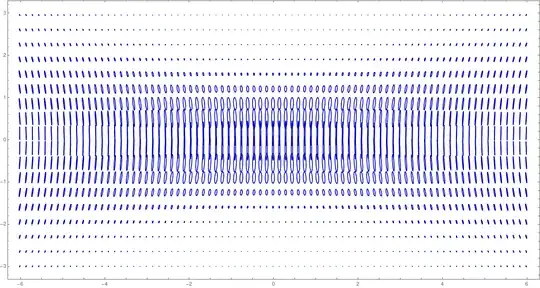In an ideal plane wave, $E$ and $B$ fields run off to infinity in both directions along straight paths. I've always assumed the center of a laser beam looks like an ideal plane wave, with $E$ and $B$ fields oscillating as one would expect from the classical picture of EM waves. But then what happens at the edge of the beam? The "light" stops, but the field lines aren't allowed to—they need to either terminate on charges or form loops. They can't go on forever in a nice uniform way, because then the beam would be infinitely wide. So what do they do?
3 Answers
This is a good model at the center of the beam,
I've always assumed the center of a laser beam looks like an ideal plane wave,
but it doesn't say anything about what happens near the edges. If you want a full model of the beam, then the basic tool we use is that of a gaussian beam, which is a solution of the Helmholtz equationparaxial approximation, whose cross-section is a gaussian with a width $w_0$ that's much larger than the wavelength of the beam.
However, it's also important to point out that gaussian beams are only valid within the limit $w_0\gg \lambda$, and even then they are not fully reliable as vector solutions, because, strictly speaking, they are not solutions of the Gauss law. To see why, consider a beam propagating along the $z$ axis with linear polarization along $x$ (so $E_y\equiv0$ by symmetry): then, as you get into the beam from the negative $x$ axis, the $E_x$ component needs to increase from zero to its maximal value over a finite expanse (however large), which means that $$ \frac{\partial E_x}{\partial x} \neq 0, $$ and therefore that if the longitudinal component $E_z=0$ vanishes, as it does in the gaussian-beam solution, the Gauss law $$ \frac{\partial E_x}{\partial x} + \frac{\partial E_z}{\partial z} =0 $$ cannot be satisfied.
So, what does this mean? Basically, it is the answer to your question,
But then what happens at the edge of the beam?
and it tells you that at the edge of the beam the vector character of the beam needs to adjust, either by tilting longitudinally or by acquiring a (small) forwards ellipticity:
Of course, if you're deep in the paraxial regime, with $\lambda/w_0\ll 1$, then these effects will be small (and indeed, to leading order, $|E_z|/|E_x|$ is proportional to $\lambda/w_0$) but they're still conceptually important.
However, that said, it's important to point out that this is mostly a misconception:
the field lines aren't allowed to—they need to either terminate on charges or form loops.
The picture of field lines is only valid in the electrostatic regime. For optical fields, we normally consider fields of the form $$ \mathbf E (\mathbf r,t) = \mathrm{Re}\mathopen{}\left[ \tilde{\mathbf{E}}(\mathbf r) e^{-i\omega t} \right] \mathclose{} $$ with $ \tilde{\mathbf{E}}(\mathbf r)$ a complex-valued vector amplitude. How do you define a field line then? And, for that definition, what theorem guarantees that those field lines will have any properties at all? (The electrostatic version is no longer applicable.) The answer is, of course, that there isn't one: in the electrostatic regime, those requirements were simply tools to enforce the Gauss law $\nabla \cdot \mathbf E = 0$, but now those tools are gone, and you're reduced to handling that PDE directly, as I've done above.
- 137,480
If I understand you correctly, you are asking about behavior of the fields in the directions that are transverse to the axis of the beam. The Gaussian beam is a good approximation to laser beams Laser beams, and, strictly speaking, it does not have an "edge". Fields decrease rapidly in the transverse directions, but do not vanish anywhere.
- 27,962
This MIT video is instructive on how lasers act. It is one in a series.
One has to keep in mind that lazing is a quantum mechanical phenomenon, and in reality there is one quantum mechanical wavefunction describing laser beams, which includes the laser crystals. This is clearly seen in the way the interference sends back energy to the lasing system.
I expect that in a mathematically complicated way, the cutoff of a laser beam's E and B fields will include the charges of the lasing atoms that produced it, loops or not, with the necessary appropriate functions. I hope somebody working with lasers will pick up this and answer in detail.
BTW, plane waves are a good approximation for relatively small distances, laser light also starts dispersing.
- 236,935
